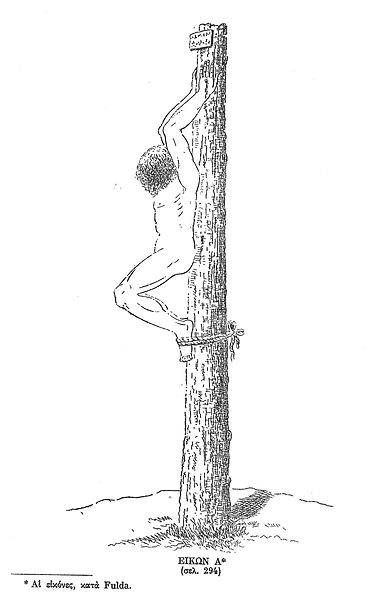Results 2,711 to 2,720 of 9617
-
09-04-2011, 09:20 PM #2711
-
09-04-2011, 10:34 PM #2712Banned User

- Join Date
- Jul 2010
- Gender

- Posts
- 2,516
 Re: The Roman Catholic Church~ Questions
Re: The Roman Catholic Church~ Questions
Basin diri pud gikan ang basis anang sign of the cross:
1 Corinthians 1:18
For the message of the cross is foolishness to those who are perishing, but to us who are being saved it is the power of God.
Galatians 6:14
May I never boast except in the cross of our Lord Jesus Christ, through which the world has been crucified to me, and I to the world.
Galatians 6:17
From now on, let no one cause me trouble, for I bear on my body the marks of Jesus.
Matthew 28:19
Therefore go and make disciples of all nations, baptizing them in the name of the Father and of the Son and of the Holy Spirit.
Pero OK raman pud kun di mo manguros, di man sab pud mo i-judge sa mga katoliko tungod lang ana. Basta dili lang magbugal2x, respeto lang sa tagsa-tagsa, wa nay 'blema.
P.S. Curious question lang, asa diay makit-an sa bible nga gidili ang pagpanguros?Last edited by yanong_banikanhon; 09-04-2011 at 10:37 PM.
-
09-04-2011, 10:46 PM #2713
-
09-04-2011, 10:47 PM #2714
-
09-04-2011, 10:49 PM #2715Elite Member

- Join Date
- Jul 2009
- Gender

- Posts
- 1,682
 Re: The Roman Catholic Church~ Questions
Re: The Roman Catholic Church~ Questions
misahan man bro.
Naay mga edad edaran nga mga pari, karo dili updated...
dili sila mo misa....
Pero mo misa na man tingae mga new generations of priests.
Ako bitaw ni gi pangutana sa amo subject canon law
ngano adunay mga pari nga dili mo misa...kato ning mga edaran nga mga pari
-
09-04-2011, 10:51 PM #2716
 Re: The Roman Catholic Church~ Questions
Re: The Roman Catholic Church~ Questions
Is There Any Mention of the Sign of the Cross in Scripture?
While there is no specific mention of making the Sign of the Cross in the Bible, some passages are interpreted in connection with the practice. The mark of salvation seen by Ezekiel (Ezk. 6:9) is regularly identified with the Sign of the Cross. Furthermore, the repetition of this imagery in the Book of Revelation is sometimes cited as evidence that this practice is of apostolic origin.
Some commentators have even identified the Sign of the Cross as a symbolic fulfillment of the injunction to “bind [the Commandments of God] to your hands and tie them to your forehead.” (Deut.6:
Read more at Suite101: The Sign of the Cross: An Introduction to an Ancient Christian Practice | Suite101.com The Sign of the Cross: An Introduction to an Ancient Christian Practice | Suite101.com
The Sign of the Cross: An Introduction to an Ancient Christian Practice | Suite101.com
basin nasayop lang jud tingali ni siya
-
09-04-2011, 11:24 PM #2717Banned User

- Join Date
- Jul 2010
- Gender

- Posts
- 2,516
 Re: The Roman Catholic Church~ Questions
Re: The Roman Catholic Church~ Questions
Way 'blema, bay.

Bahin anang imong pangutana nga imong gi-insert sa akong post, let me try to answer it by a question.
Kun para sa mga nangaluwas, simbolo sa kaluwasan ang cross (1 Cor 1:18 ), unya gipanghinambog mismo ni Pablo ang cross ni Jesus (Gal 6:14, 17), unya imo pud mabasa sa bible ang words nga gigamit sa pagpanguros (Mat. 28:19), dautan diay nga i-combine ni tanan into a simple, humble gesture called the 'sign of the cross'?
Kun mao, asa man makit-an sa bible nga gidid-an ang mga tawo sa pag-sign of the cross?
-
09-04-2011, 11:40 PM #2718
 Re: The Roman Catholic Church~ Questions
Re: The Roman Catholic Church~ Questions
Let's start with how "pagpanguros" started. It started way back fourth century, when pagan Emperor Constantine became a convert to apostate Christianity and promoted the cross as its symbol. Whatever his reasons, it has nothing to do with Jesus Christ. Logic will tell that what was promoted as a symbol of Christianity was in fact pagan in origin.
Galatians 3:13 says "Christ by purchase released us from the curse of the Law by becoming a curse instead of us, because it is written: 'Accursed is every man hanged upon a stake.'" So, it is improper for Christians to use "pagpanguros" in a prayer since it is a sign of a curse.
Also, Jesus Christ did not die on a cross but on a stake. The Greek word for that is stau·ros′ which means a stake, an upright pole, or piece of paling. A stake or a torture stake was often used for execution. See below example:
Again, it is improper to use symbols in devotion to God and this is clearly condemned in the Bible. (2 Corinthians 6:14-18; Exodus 20:4, 5; 1 Corinthians 10:14)Last edited by cliff_drew; 09-04-2011 at 11:45 PM.
-
09-04-2011, 11:40 PM #2719
 Re: The Roman Catholic Church~ Questions
Re: The Roman Catholic Church~ Questions
awkie raman guro mesahan
kung ng pakamatay ang tao tungod kapoy na iyang kinabuhi the show must go on patay na kung patay" wala may gi pili ang ginuo kung unsa ka tao!
-
09-04-2011, 11:50 PM #2720
Advertisement
Similar Threads |
|






 Reply With Quote
Reply With Quote



